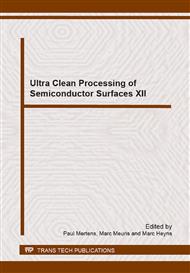p.143
p.148
p.153
p.157
p.161
p.165
p.170
p.177
p.183
Fluid Flow and Defect Density Considerations when Drying Bumped Wafers Using Spin and Surface Tension Gradient Methods
Abstract:
Spin rinse drying (SRD) and surface tension gradient drying (STG) are used to clean and dry wafers after wet processing. These methods are effective at removing surface fluid and fluid trapped by capillary forces in small (<1um) features. SRD and STG processes combine driven fluid flows with controlled evaporation of thin water films to leave a dry wafer with low defect density (i.e. a low number of physical particle process adders, or areas of haze or oxidation).
Info:
Periodical:
Pages:
161-164
Citation:
Online since:
September 2014
Authors:
Price:
Сopyright:
© 2015 Trans Tech Publications Ltd. All Rights Reserved
Share:
Citation:


